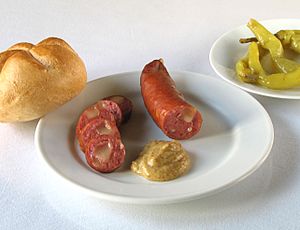Carniolan sausage facts for kids

Carniolian sausage, Ljubljana, Slovenia
|
|
| Course | Sausage |
|---|---|
| Place of origin | Slovenia |
| Region or state | Territory of the former Carniola |
| Main ingredients | Pork Garlic |
| Variations | Käsekrainer |
The Carniolan sausage (called kranjska klobasa in Slovenia) is a yummy Slovenian sausage. It's a bit like the "kielbasa" or Polish sausage you might know.
The word klobasa means a small sausage in Slovene. It's usually served whole. The word kranjska comes from a region called Carniola. This used to be a duchy, which is like a small kingdom, in the old Austrian Empire.
People first wrote about the Carniolan sausage in a German cookbook. This famous book, Süddeutsche Küche, was written by Katharina Prato in 1896. The Slovene name kranjska klobasa first appeared in a Slovene cookbook in 1912. This book was called Slovenska kuharica by Felicita Kalinšek.
Carniolan sausages are mostly made from pork. They contain at least 75% to 80% pork meat. They also have up to 20% bacon. A little bit of water, sea salt from Sečovlje salt pans, and some garlic are added. A special salt called saltpetre and black pepper are also used. No other ingredients are allowed in this traditional sausage.
The meat is cut into small pieces. The bacon is cut into slightly smaller pieces. This mix is then put into a pork intestine. The sausage usually has a diameter of about 32 to 36 mm. Sausages are made in pairs, each about 12 to 16 cm long. Each pair weighs around 180 to 220 grams. The pairs are linked together with a small wooden stick. Finally, the sausages are smoked and cooked with heat. This happens at about 70 °C (158 °F).
Different Kinds and How to Cook Them
A popular version of this sausage is called Käsekrainer. This type has small pieces of cheese mixed in. It contains about 10% to 20% cheese. Cheeses like Emmentaler are cut into small cubes and added.
Käsekrainer were first made in Austria in the early 1980s. Today, you can find them at almost every sausage stand in Austria. These sausages can be boiled, baked, or grilled. It's important to cook them on low to medium heat. If the heat is too high, the outside might burn. The inside could stay cold.
Be careful when cooking Käsekrainer. The cheese inside can get very hot. Do not cut or poke the sausages while they are cooking. If you do, the melted cheese might leak out.
You can serve the Carniolan sausage with mustard or ketchup. A piece of dark bread often goes with it. In Austria, a common way to eat Käsekrainer is as a "Hot-Dog". In Austria, "Hot Dog" means the bun, not the sausage itself.
The bun used is like a French baguette but shorter. It's usually 200 to 250 mm long. It has a different texture and recipe. A hole is poked into one end of the bun with a warm metal rod. Then, sauce is put into the hole. People in Austria often choose from sharp mustard, sweet mustard, or ketchup.
In the 1940s and 1950s, people from Croatia and Slovenia moved to Australia. They brought kranjska klobasa with them. There, it became known as Kransky. Cheese Kransky is now very popular in both Australia and New Zealand.
Special Protection for the Sausage
In January 2015, Slovenia got special protection for the Carniolan sausage. It was added to a list of protected geographical indications (PGIs). This means that only sausages made in a certain way and from a specific area can be called "Carniolan sausage". Some countries, like Austria, Croatia, and Germany, had some concerns. But Slovenia still managed to get this protection.
- Protected geographical indication (PGI) in the European Union
See also
 In Spanish: Kranjska klobasa para niños
In Spanish: Kranjska klobasa para niños


